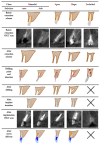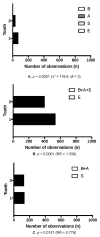The Anatomical Conditions of the Alveolar Process of the Anterior Maxilla in Terms of Immediate Implantation-Radiological Retrospective Case Series Study
- PMID: 33920026
- PMCID: PMC8071063
- DOI: 10.3390/jcm10081688
The Anatomical Conditions of the Alveolar Process of the Anterior Maxilla in Terms of Immediate Implantation-Radiological Retrospective Case Series Study
Abstract
The feasibility and the level of difficulty of immediate flapless implantation depend largely on the residual alveolar bone. The purpose of the study was to determine how often immediate flapless implantation in the anterior maxilla is feasible and assess the difficulty level using cone-beam computed tomography (CBCT) scans. A radiological retrospective case series study was conducted. In total, 1200 CBCT scans from 300 consecutive patients were analyzed with dedicated planning software. Immediate flapless implants were possible in 78.33% of cases. Drilling direction was either through the apex or the palatal slope. Bimodal was conducted in 9% of the cases; only through the apex in 13.08% of the cases and in 56.25% only in the slope. In 21.67%, immediate flapless implants were excluded. The feasibility and degree of difficulty differed statistically to the disadvantage of the lateral incisors compared to the central incisors. Drilling direction caused that BASE classification reflects the difficulty level of immediate implantation. CBCT is a helpful diagnostic tool for assessing the feasibility of immediate flapless implants due to the residual bone shape and volume. BASE classification helps to determine a challenge level that may also facilitate communication and result in comparison. The alveolar bone condition allows for immediate flapless implants in most cases in the aesthetic region of the maxilla, but they should be performed by an experienced specialist with regard to the bone and soft tissue quality.
Keywords: aesthetic region of maxilla; alveolar bone shape; bone anatomy; classification; cone-beam computer tomography (CBCT); dental implants; flapless implants; immediate implantation; predictable implantation.
Conflict of interest statement
The authors declare no conflict of interest.
Figures





References
-
- Cosola S., Marconcini S., Giammarinaro E., Poli G.L., Covani U., Barone A. Oral health-related quality of life and clinical outcomes of immediately or delayed loaded implants in the rehabilitation of edentulous jaws: A retrospective comparative study. Minerva. Stomatol. 2018;67:189–195. - PubMed
-
- Doornewaard R., Bruyn H., Matthys C., Bronkhorst E., Vandeweghe S., Vervaeke S. The Long-Term Effect of Adapting the Vertical Position of Implants on Peri-Implant Health: A 5-Year Intra-Subject Comparison in the Edentulous Mandible Including Oral Health-Related Quality of Life. J. Clin. Med. 2020;9:3320. doi: 10.3390/jcm9103320. - DOI - PMC - PubMed
-
- Wychowanski P., Szubinska-Lelonkiewicz D., Osiak M., Nowak M., Kosieradzki M., Fiedor P. New Approach to Treatment of High-Risk Allograft Recipients under Chronic Immunosuppression with Tooth Loss. Evaluation of Safety and Longevity of Dental Implants: A Case Report. Transplant. Proc. 2020;52:2558–2562. doi: 10.1016/j.transproceed.2020.02.103. - DOI - PubMed
LinkOut - more resources
Full Text Sources
Other Literature Sources
Miscellaneous

